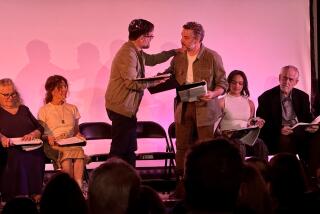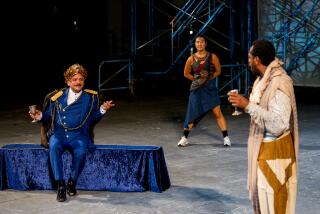Exploring the Uses, Abuses of Violence in Theater
Images of onstage violence from the Greeks to the present day filled the air at UC Riverside over the weekend.
A queenâs daughter rips open her robes. âStrike, captain. Here is my breast. Will you stab me there? Or in the neck?â The sword slashes, blood gushes. (Euripidesâ âHecuba.â)
An emperorâs daughter is raped, then her hands are cut off and her tongue is cut out. (Shakespeareâs âTitus Andronicus.â)
A woman is sexually violated in her own home and extracts an equally brutal revenge. (William Mastrosimoneâs âExtremities.â)
Is it socially useful to show such things on stage? Is there a right and wrong way to go about it? Nearly 100 scholars from campuses around the country were exploring the role of violence in theater at the universityâs 10th annual Themes in Drama conference.
The gathering featured an unsparing live performance entitled âImages in Violenceâ by a fierce New Hampshire-based theatrical troupe, the Geese Theatre Company. Until Saturday night the group had performed exclusively in penitentiaries, doing plays about convicts.
The actorsâ torrid theater of shock dramatized the underlying theme expressed in academic papers all weekend: the strategy of using onstage violence to compel change in the spectator.
The sessions, 32 in all, probed cruelty and barbarity through centuries of drama. The thrill of tragedy, the pleasure of pity, the use of seemingly gratuitous violence (Gloucesterâs blinding in âKing Learâ) were in flower once again.
Subjects ranged from âLesbian Sexuality and Violence in the Plays of Bernard Shawâ to the verbal violence of Harold Pinterâs plays, described by the author in a BBC video as âmetaphors for authoritarian postures.â
One conference participant, John Callahan of Kutztown University north of Philadelphia, cautioned about the pitfalls of staging physical violence.
âI had a student playing Othello,â he said. âOn opening night he squashed a pillow over the face of Desdemona with such strength and fervor that the actress almost suffocated.â
A motif of the three-day event was âthe distinction between right and wrong kinds of violence,â as Yale English professor Thomas Gould put it.
Tragedy, Gould said, makes the viewer âfeel the terrible unfairness of life,â as in the âIliad,â where âall the deaths are regrettable. Nobody wins.â
In contrast, gratuitous or melodramatic violence âmerely whets our appetite for guilt-free revenge. . . . The pleasure can be so intense that audiences at a film will shout at the most brutal moments.â
In one of the conferenceâs few digressions to Hollywood movie violence, Gould added: âShowing us violence realistically and in impressive detail, something film is especially good at, is not dangerous in itself.
âIt is of dubious value only if we are invited to see ourselves personally in the role, not of the victims, but of the perpetrator. The films of Sylvester Stallone come to mind, also martial arts films from Hong Kong, âThe Equalizerâ and several police series on television.â
From âAristotle: On the Necessity of Violence in Dramaâ (playfully subtitled âA Greek Tragedy Construction Kitâ) to Tennessee Williams (âA Streetcar Named Misogyny--Violence Against Women in âA Streetcar Named Desireâ â), the symposium characterized the use of violence in drama as a moral imperative.
William Hutchings, from the University of Alabama at Birmingham, quoted British playwright Edward Bond: âViolence shapes and obsesses our society. It would be immoral not to write about it.â
Hutchings said that depictions of violence in the theater âare far less gratuitous than those in the mass media, where Rambo, Jason and Freddy Krueger as well as nameless âRoad Warriors,â âNight Stalkersâ and âTerminatorsâ are depicted with ever gorier special effects.â
On the other hand, Shakespeare professor Jonas Barish of the University of California at Berkeley dryly noted, referring to a litany of bloody scenes from Shakespeare, that âElizabethans were used to seeing the heads of those executed as traitors spiked on the Tower of London.â
Selected essays read at the conference will be published later this year by St. Martinâs Press under the title âThemes in Drama.â
More to Read
The biggest entertainment stories
Get our big stories about Hollywood, film, television, music, arts, culture and more right in your inbox as soon as they publish.
You may occasionally receive promotional content from the Los Angeles Times.










